How to Make a Clasp — Clasp Ideas You Can Make Yourself
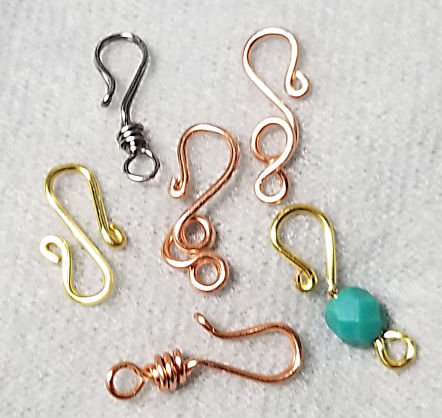
Examples of Clasps
How to make a clasp…is it difficult? No, it’s not, as long as you have some wire and feel like playing! Making your own clasps gives you the opportunity to customize your jewelry even further. It also helps when you realize you don’t have a clasp the right size, LOL. You can make one just as large or as small as you need!
Clasp Wire – What Gauges to Use?
Ideally, you would use 18 gauge or 16 gauge for any clasp design that is made from a single wire (as opposed to some clasps which have a doubled wire). Most often, I use 18 gauge wire, and I will work-harden it afterwards with a rubber mallet or a chasing hammer. However, I don’t always need to do the work-hardening for 18 gauge, especially if my jewelry project is lightweight.
If I have a design that uses doubled wire, I tend to use either 20 gauge or even 22 gauge.
If I have a design that uses any wire weaving techniques, 20 gauge is my favorite, as the wire weaving stabilizes the wire.
Now most jewelry wire is sold as “dead soft”, which is ideal for shaping. However, if you don’t want to fiddle around with work hardening your 18 gauge wire, you can try using half-hard wire. It’s more difficult to shape, but it holds that shape well.
Keep in mind that when I talk about gauges, I am referring to the “AWG” gauge, which is the traditional measuring system for jewelry wire. If you pick up some wire listed as “SWG”, keep in mind that anything under 20 gauge has a different wire diameter — it’s generally one size larger than AWG. It makes a difference as to how easily the wire bends.
Time to Make Some Clasps!
Here’s a video on making clasps — just a few ideas. These are fairly simple, and meanwhile, I am thinking up some other designs that are a bit more elaborate, for when you want that extra-special touch!
Get Wired Up! Wrapping, Knitting, Weaving and More
I’ve enjoyed working with wire for many years — in fact, it’s what drew me into making jewelry in the first place! I started with wire work (also known as wire wrapping), then moved onto chain maille, then viking knit, wire crochet and now wire weaving.
So which is my favorite? Hard to choose for sure! In fact, I don’t know that I can choose a favorite, other than to say whichever I feel like working on is my favorite, LOL.
Wrapping Versus Weaving – Is There a Difference?
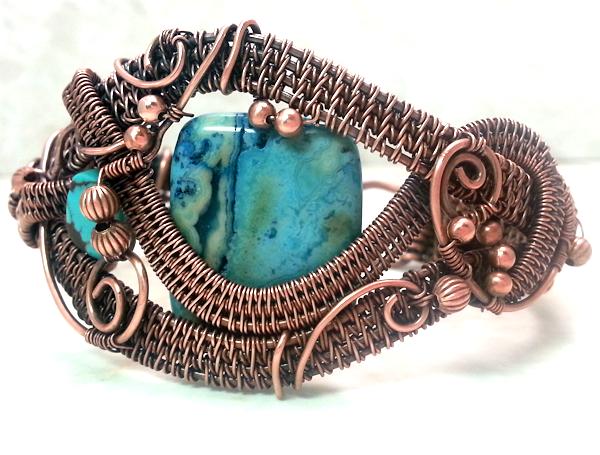
This was actually the very first wire weaving bracelet I ever made. Turned out much better than I had expected. 😀
Some people say there is no difference — that both are just manipulating wire into different shapes. Me, I think there is a difference. When I started with the wire wrapping, it was all about wrapping it around an object. Wire wasn’t made into shapes for the sake of the wire, but to capture something.
Wire weaving, on the other hand, features the wire. There may be a bead or cabochon involved, like in the photo to the right, the real star of the show is the weaving.
There are plenty of patterns for the weaving, involving from two to a zillion base wires. OK, maybe not a zillion, but the bracelet in the photo ended up using 8 base wires in places.
If you’re interested more in manipulating wire, here’s my Youtube playlist on wirework of all kinds.
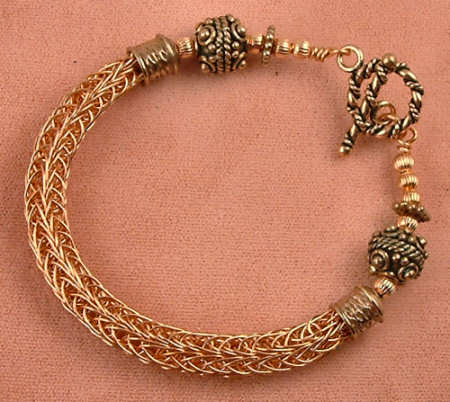 Viking Knit
Viking Knit
I did (and still do) find viking knit very intriguing. I can’t knit a darned thing with yarn, but I discovered that wire was much easier – for me, at any rate.
Most of the time, viking knit is the means and the end — the wire is very definitely the star. There may be beads incorporated into the jewelry like in the photo to the left, but the emphasis is on the wire knitting.
And similar to wire weaving, there are different patterns that one can use to create jewelry. Single knit and double knit are the most popular, though.
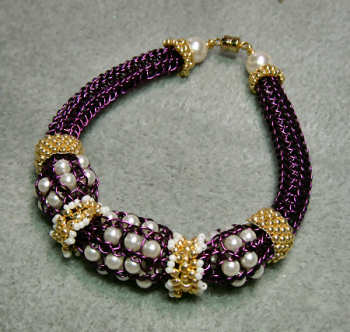
Viking Knit Jewelry Embellishments
But…if you are interested in something a with a little more integrated, you can do more. How much more? Take a look at the image on the right.
In this bracelet, the viking knit shares the stage with beads. Not just pearls, but also seed beads.
In addition to single knit and double knit, triple knit is also an option. It does make the chain stiffer, but it is quite dense and lovely.
There is also a layered knit which is kind of cool.
If you’d like more info on some more advanced viking knit, check out my ebook tutorial.
Wire Crochet
This is something I’ve only really dabbled in. I like the freedom it provides — the technique is quite organic in nature. Up to now, I’ve primarily worked with varying the size of the stitches within the project and adding random beads. I think my next challenge will be to regulate the size of the stitches and use the same beads within the project. If I can get it worked out, I’ll set up a video for it.
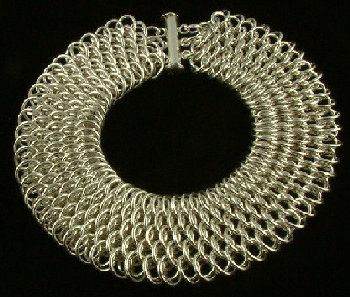
Dragonscale Bracelet, Sterling Silver
Chain Maille
Oh, I’ve got lots of posts on chain maille, and even a second site devoted to it — chainmaillejewelrypatterns.com. I get a kick out of chain maille, and it makes for some gorgeous jewelry.
When I started out with chain maille, sterling silver jump rings were relatively inexpensive — silver was around $7/ounce. I got lots and lots of rings, in all kinds of sizes and gauges. And I set my fingers to maille-ing.
The photo to the left is a pattern called “Dragonscale”. The weave is quite dense, and this particular bracelet was made with sterling silver — talk about substantial! I did sell it and I kind of wish I hadn’t, seeing as I’ve not made another such bracelet again. Well, I take that back…I started another one, but with copper wire, and I haven’t finished it.
I’m also getting ready to publish another ebook for HP 3-in-1 and HP 4-in-one. And in that ebook, I have a pattern called “Dragonback”. That weave is also pretty substantial, but this time I did it in copper. (Once I have it finished, I’ll put a link here.)
Getting Started With Wire
If you’re interested in starting to work with wire, here’s what I would recommend. And the first would be to use copper wire — it’s inexpensive and soft on the hands. Well, maybe “soft” isn’t quite the right term, but it’s much easier to manipulate than brass, bronze or sterling.
I’d recommend a few different wire gauges to start — 18, 20, 22, 26 and 28 are good choices. The 26 and 28 gauges are great for viking knit and crochet. Most of the wire weaving I do are in gauges 22, 26 and 28. However, the heavier gauges are better for parts of the project that are more load-bearing.
Chain maille — again, I suggest copper as your introduction. And I will refer you to my free guide for chain maille rings for a more in-depth discussion for what you should look for in your rings. It will help you to understand things like AR, ID and OD which are very important to your project success.
I hope this post has been helpful, and that you enjoy your journey into working with wire!